August 2016
STAR Newsletter
August 2016 edition
Contents:- Summer Students & Public Outeach
- Summer Sunday Recap
- From the Spokesperson
- Collaboration Members in the Headlines
- Software & Computing
A note from the editor: as a collaboration-wide communication tool, this newsletter is set up to allow comments (subject to moderation against abuse), and all STAR Collaborators are welcome to do so! Please keep in mind that some content (including all comments) may be considered internal to the Collaboration and only accessible when logged into Drupal. Documentation is available here.
Summer Students & Public Outreach
(Rebecca Siddall - Student, Oundle School, UK; introduction by Aihong Tang - BNL)
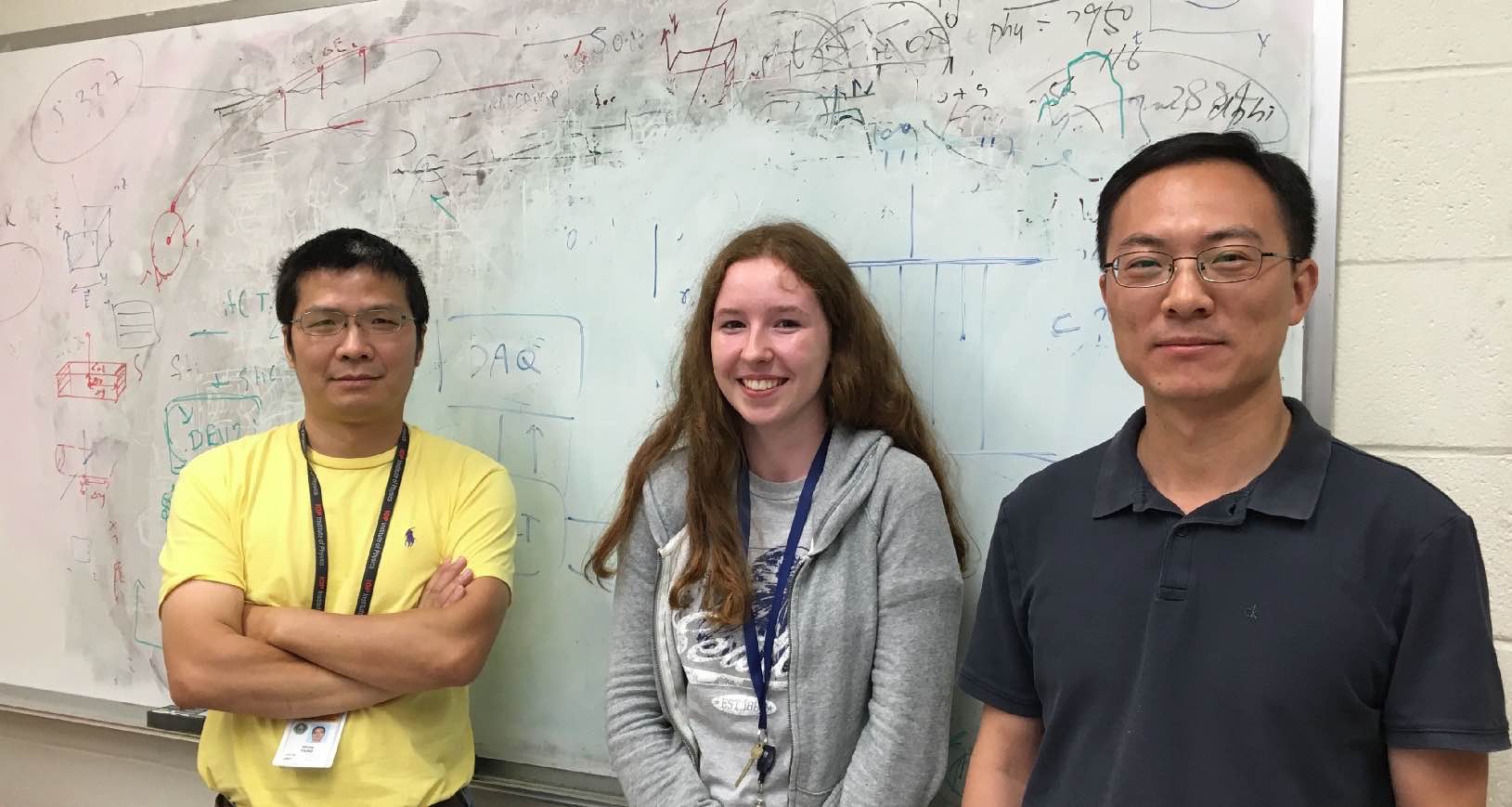
Left to right: Aihong Tang, Rebecca Siddall, Hongwei Ke.
Simple Maths, Antimatter, and the Birth of the Universe
by Rebecca Siddall
If x2 = 4, then what is x? Did you just think “2”? Is that correct? Well, yes and no...
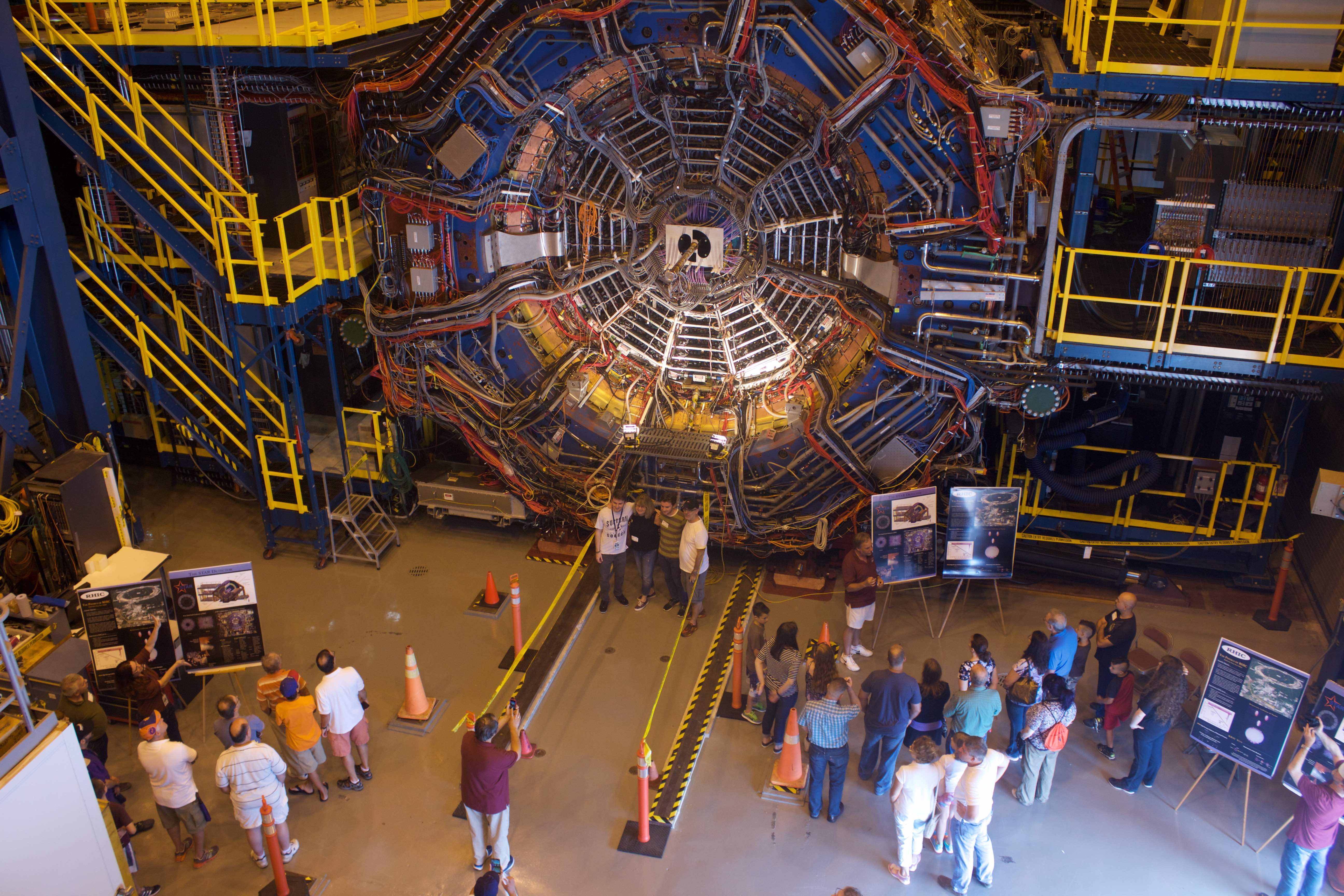
Volunteer guides giving tours to (and taking photos of) visitors at STAR. Click on the photo to view full size.
(Gene Van Buren - BNL)
Continuing with Public Outreach, fifteen people from STAR helped make this year's Summer Sunday event on July 31st at BNL an unqualified success. As noted in the last Newsletter, this is an annual open house for the public to see and learn about RHIC experiments & science, as well as meet those involved in the reasearch. Among the different facilities at BNL, the Sunday devoted to RHIC has always been very popular, and this year proved no exception with approximately 1300 visitors to BNL (the number is imprecise because many employees bring friends and family who don't go through the orientation).
Once the visitors got off the transport bus at STAR, they entered an Assembly Hall bay door to take in an awesome view of the STAR detector. Our volunteer guides then took the visitors in manageable groups to poster stations, as can be seen in the photo shown at right. The tours progressed into the Wide Angle (Experiment) Hall, through the DAQ room, and concluded in the STAR Control Room before circling back to the bus pick-up and drop-off area.
Many thanks to this year's volunteers (in no particular order): Shuai Yang, Alexei Lebedev, Rosi Reed, Stephen Trentalange, Hongwei Ke, Lijuan Ruan, Robert Pak, Jack Engelage, Bill Christie, Flemming Videbaek, Eric Kilgore (summer student at BNL), Prithwish Tribedy, Bob Tribble, and Gene Van Buren.
Special thanks to Bob Soja who, with Bill, always sets up a safe and spectacular viewing area for the visitors.
From the Spokesperson
(Zhangbu Xu - Spokesperson)
Dear STAR Collaborators:
We are approaching the end of summer break for most of the schools and vacation peak season. During the last two months, there have been many progresses and reviews.
A STAR Collaboration Meeting was held at Ohio State University on August 15th-20th with 116 registered participants. Invited speakers came for Juniors Day, as well as for theory talks on the Beam Energy Scan (BES), jet physics, and spin programs. The second Town Hall meeting of the year was structured to ask and discuss three important questions:
1) What constitutes a BES-II discovery/success, and what follows it?
2) How will we build on Run 17?
3) What do we expect from the Runs 14-16 heavy-flavor program, and what is next?
Provocative answers and questions were discussed in a lively debate before we retired to the Ohio Union for the meeting reception. Thanks go to Mike Lisa, John Campbell, and others for a great meeting!

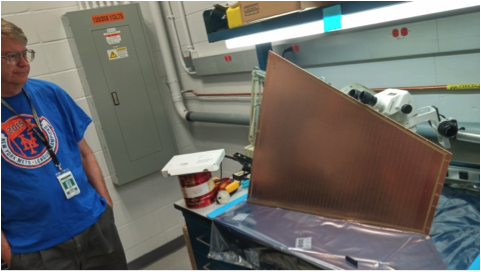
I would also like to welcome three new institutions: University of California at Riverside (represented by Prof. Ken Barish), University of Tsukuba in Japan (represented by Prof. ShinIchi Esumi) and Technische Universität Darmstadt (represented by Prof. Tetyana Galatyuk and associated with BNL). All three institutions have excellent track records in the field with different strengths in physics subjects. We are looking forward to a productive collaboration.
The DOE conducted its biennial review on the RHIC facility on August 23rd-25th. The agenda and talks are available here. The overall evaluation of the RHIC performance was quite positive. The major comments at the close-out related to STAR were:
- Endorse PAC recommendation of STAR submitting a plan for beyond BES-II in 2018
- Promise feedback from DOE for the Cold QCD plan ASAP
- Suggest a possible Detector Readiness Review for new subsystems before the Run
Much progress has been made recently on the iTPC and EPD projects. During the collaboration meeting, I was fortunate to take a picture (with my cell phone) of Mike Lisa and Rosi Reed moving the first full sector of the EPD from the lab to the machine shop at OSU. In the second photo, Jim Thomas is among those excited at the reception of the first iTPC padplane. We have obtained the iTPC SAMPA chip from CERN and Tonko has been able to communicate to the chip with our own iFEE card.
We will soon see talks and new results releasing for the coming INPC and SPIN conferences, and abstracts for Quark Matter 2017. Looking forward to all these exciting scientific results in the coming months!
Collaboration Members in the Headlines
Congratulations go out to the following STAR Collaboration Members:
- Kathryn Meehan
-
Recipient of the 2016 Gertrude Scharff-Goldhaber Prize:

Meehan is helping lead the fixed-target program - aiming a beam at a stationary target to see what particle interactions occur - at the STAR detector at Brookhaven Lab's Relativistic Heavy Ion Collider (RHIC)... Meehan's thesis research focuses on comparing results from STAR's first dedicated fixed-target test run with results from Brookhaven's Alternating Gradient Synchrotron (AGS), a particle accelerator that receives protons and other ions from the AGS booster and delivers them to RHIC after acceleration. This research may provide important information leading to the groundwork for future fixed-target experiments.
Meehan earned her B.S. in Physics and Astronomy at Haverford College in Pennsylvania and is currently a Ph.D. Candidate at the University of California-Davis. She also serves as a student representative on the Users' Executive Committee. - Paul Sorensen
-
Appointed by DOE Nuclear physics to be the new Program Manager for Fundamental Symmetries:
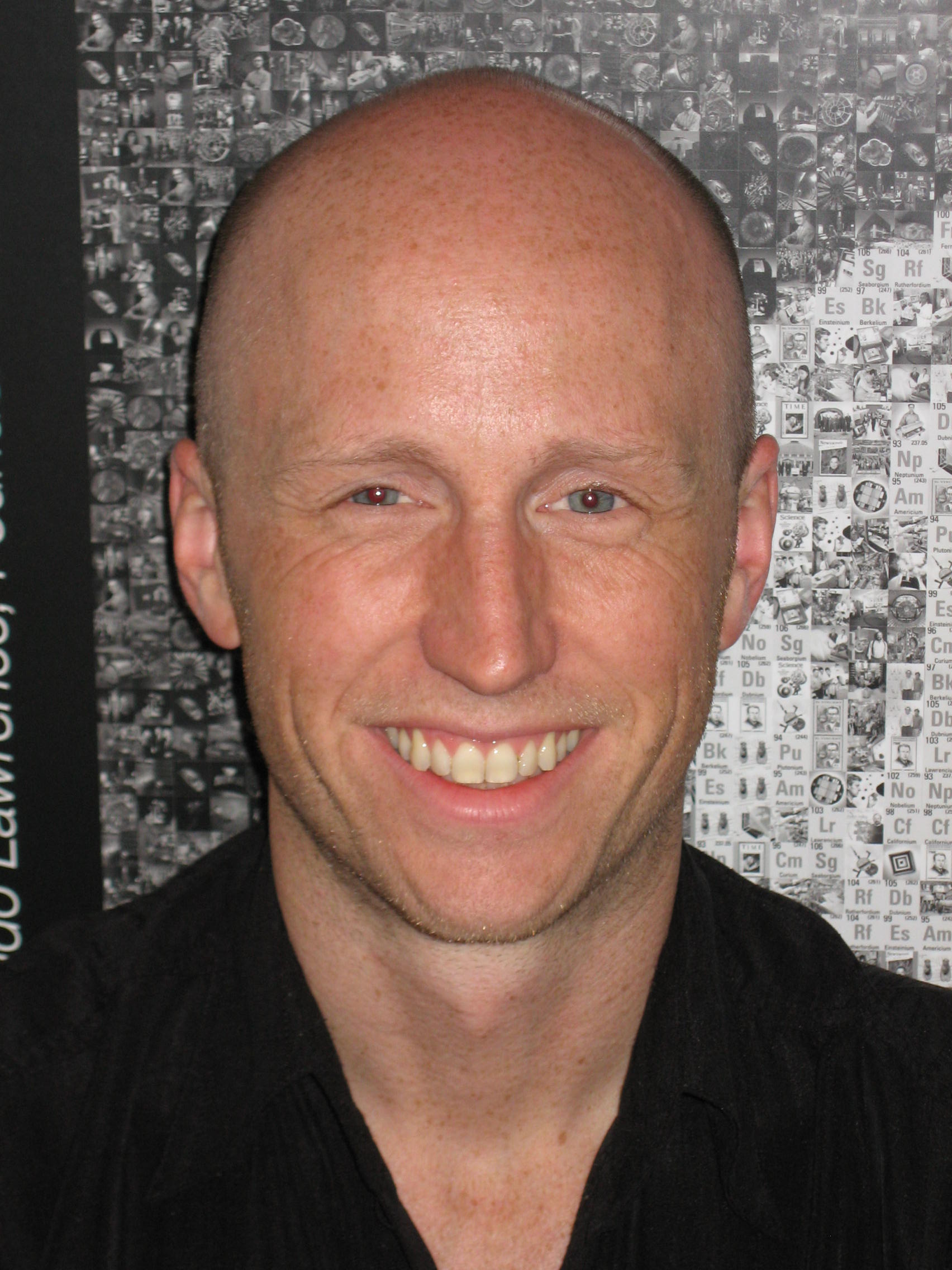
Paul is serving in this role under an Intergovernmental Personnel Act (IPA) appointment, and with few exceptions will execute his duties under the full authorities that attain to other Federal Program Managers within NP. Paul comes to NP from Brookhaven National Laboratory as an accomplished member of the relativistic heavy ion community. Among his other accomplishments, Paul received the 2008 George E. Valley Prize from the American Physical Society in recognition of his singular accomplishments in heavy ion physics.
Paul has expressed a keen interest in stewarding a suite of ground-breaking NP experiments in fundamental symmetries, in part as a result of his intense interest in turning the nuclear science event-horizon clock back before the creation of the quark-gluon plasma to a time when the symmetries of nature observed today spontaneously emerged from the early cosmos. He has already embarked on a fact-finding tour with members of the FS community to rapidly learn the opportunities and challenges within this discipline.Tim Hallman, Associate Director of the DOE Office of Science for Nuclear Physics - Lijuan Ruan
-
Selected to deliver the 2016 Sambamurti Memorial Lecture:
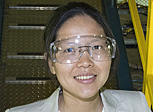
During this lecture, Ruan [explained] how she uses electron-positron tomography from quark-antiquark annihilations to study mirror-like chiral symmetry, a characteristic that "broke"—resulting in the formation of 99 percent of the visible mass in the universe—and is thought to be restored during ion collisions at RHIC...
Ruan arrived at Brookhaven Lab as a Goldhaber Distinguished Fellow in 2007. This prestigious fellowship—funded by Brookhaven Science Associates, the company that manages Brookhaven Lab for the U.S. Department of Energy—is awarded to candidates with exceptional talent and credentials who have a strong desire for independent research at the frontiers of their fields... The International Union of Pure & Applied Physics awarded her the Young Scientist Prize for Nuclear Physics in 2010 and the U.S. Department of Energy recognized Ruan with an Early Career Research Program Funding Award in 2013.
The Sambamurti Memorial Lecture was established to commemorate the work of Aditya Sambamurti, a young Brookhaven physicist who died of cancer in 1992 at age 31. Each year, an outstanding young physicist whose professional interests overlap those of Sambamurti is selected to deliver the lecture. [Editor's note: find other STAR Collaborators who have garnered this lectureship here.]
Software & Computing
(Jérôme Lauret - S&C Leader;
Gene Van Buren - S&C Co-Leader)
The recent OSU STAR Collaboration Meeting provided an opportunity for many of the activities related to STAR Software & Computing to be presented. In this article, we will briefly summarize some of those presentations.
Overall, there is much progress within the subsystems' efforts (see presentations on You do not have access to view this node, You do not have access to view this node, and You do not have access to view this node) while many activities continue to bring STAR to the next frontier. We had a very good You do not have access to view this node (wrapping up at the end of the Run what went well and what not so well), which has helped over the years identify and consolidate the areas that are most critical. Of course, S&C continues to rely on help from many channels, from good communications with the PWGs, to the focused duty attendance from the Collaboration such as covering the Offline QA shifts.
While the resources are constrained, data productions as well as embedding productions (see You do not have access to view this node) are well on schedule. Scheduling follows priorities provided by the PWGC with an eye on optimizing for farm utilization. STAR S&C is investigating many avenues to increase its pool of resources - the Cori R&D (see You do not have access to view this node) opens the lane to vast computational resources in High Performance Computing (HPC) not utilized before - we intend to now move on submitting an official allocation request to NERSC. As before, those resources are at reach thanks to STAR participation and collaboration to the Open Science Grid (OSG).
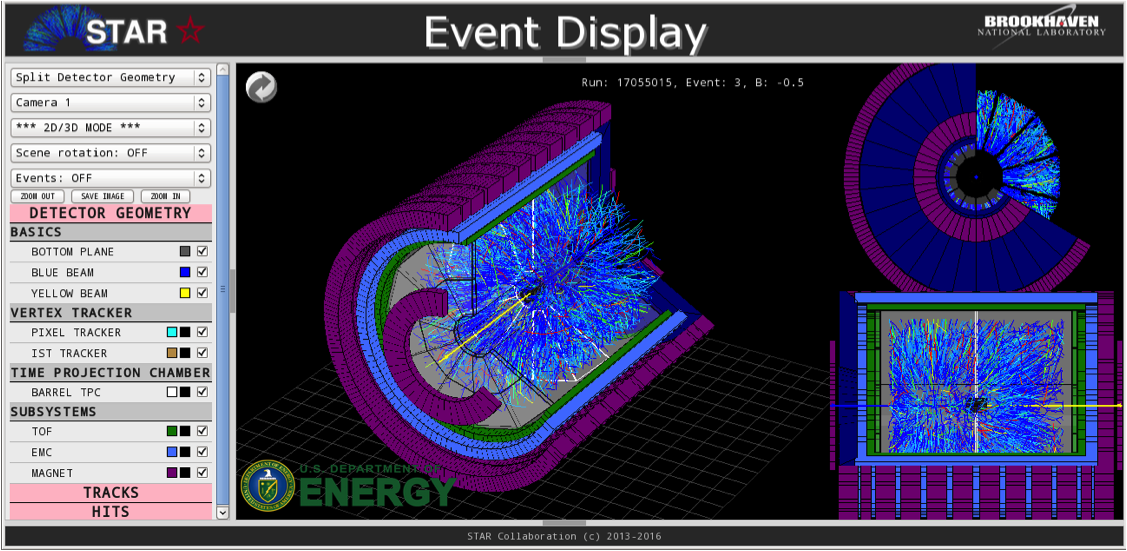
We have many to thank for the progress and in this issue, special thanks go to the software coordinators as well as the active PWG coordinators & members who have helped, together, to bring to fruition key components fundamental to sustaining our scientific throughput.
Previous Edition: June 2016
Groups:
- Printer-friendly version
- Login or register to post comments

